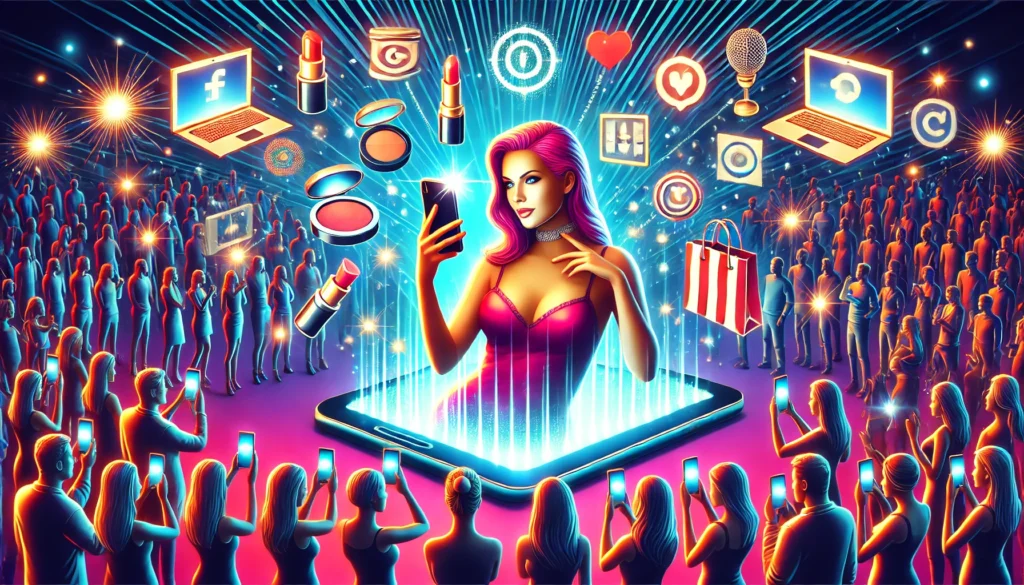The rapid rise of social media allows ceaseless exposure to popular influencers, brands, and products. Fashion influencer micro-celebrities come forth with a unique lifestyle, and as such, they can be difficult to approach directly. There’s a necessity to investigate the behind-the-scene inner worlds of these fashion influencers to uncover the non-marketing-affiliated links to brands and fashion trends [1]. Influencer micro-celebrities own both rewards and challenges. On the one hand, micro-celebrities enjoy free products, invitations, and bigger brand stimulation. However, they need to relentlessly prove their relevance and credibility and face a never-ending stream of comparison, scrutiny, and backlash. This makes them feel unworthy, driven by anxiety, and pressured to spend more time on social media.
1. Introduction
Some influencers’ strategies are technology-related by using filters or by mastering the ways Algorithms work and other strategies are content-related by working on narrative or specific kinds of content. Videos on fashion influencers’ accounts tend to have more engagements than photo-only posts [2]. Still, other beauty influencers shared before and after methods, then continued to make all their videos show the whole transformative process implemented in three main parts: applying the products, letting it dry for a certain period of time, and eliminating the product to show the final look.
2. The Rise of Influencer Culture
In ‘The Rise of Influencer Culture’ section, the emergence and growth of influencer culture are explored. This includes a historical perspective, key milestones, and the factors contributing to the rise of influencer culture. The significant impact of influencers on various industries and consumer trends is discussed, setting the stage for understanding their influence on consumer behavior.
The advent of social media platforms such as Twitter and Facebook facilitated the rise of influencers. Influencer marketing works well for brands because of the influencer’s highly engaged followership. An influencer is any person in a position to affect the decisions of others. Companies and their brands began to pay close attention to it to fulfill marketers’ goals. Brands used various platforms to promote their products or services, targeting many consumers through celebrities and non-celebrity personalities. Instagram may be the greatest influencer marketing tool today, with 800 million monthly active users, of which, 500 million use the platform every day [3].
Instagram is a popular social media platform for sharing images. The images may show the products used by these influencers and how it can be styled. It can also display the influencer’s personal lives, creating intimacy and a connection with the audience. Instagram is highly favored by the millennial generation, a generation highly targeted by marketers. Many influencers feel that they have a unique voice that can reach the masses and provide knowledge on how to consume it properly to create a better lifestyle [2].
3. Understanding Consumer Behavior
The current era is regarded as the era of social media and Instagram influencers. When discussing social networks, it becomes necessary to analyze different generations. Generation Z is the most concerned one about social network usage and their impact on consumption behavior [2]. This generation follows a more visual and influencer-oriented approach. In 2017, an investigation by IPSOS disclosed some interesting results regarding the impact of influencers on purchase decisions or general attitudes towards brands. This was further confirmed by some relevant neuro-marketing studies. Hence, it becomes important to analyze Generation Z’s consumption of social networks, the influencers they follow, their motivations regarding this following process, as well as the impact of this following on purchase decisions and brand attitudes. A better appropriation of social network influencers’ mechanisms is going to benefit companies by helping them determine relevant targets and strategies. Furthermore, it would allow for a reconciliation regarding the approach and budget, depending on the targeted generation.
The past research in consumer behavior initially focused mainly on motivation, but later on the importance of the cognitive components was discovered. This body of knowledge is very broad and gradually increases. It is meant to analyze the complexity of consumer acts, trying to explain the mechanism of purchase and consumption decisions. The difficulty in explaining these mechanisms is related to the relatively high complexity of the behavior itself. The difficulty in modeling is also related to the fact that the consumer behavior is subject to continuous change, the changes being sometimes abrupt [4]. An additional impediment is the need of a systemic approach, in the sense that the consumer must be compared to a “black box” on behalf of whom various influences are transmitted (stimuli) and on behalf of whom various reactions and responses appear (purchase, use, and disposal).
4. Influencer Marketing Strategies
Influencer marketing is an approach in which marketers seek out and build relationships with online influencers. The goal of influencer marketing is to reach consumers who are shaped and influenced in their purchasing decisions by trusted personalities on social media. Online social influencers essentially act as intermediaries between brands and consumers. They own and maintain blogs, Instagram accounts, YouTube channels, etc. with highly engaged audiences. indicates that there is an understanding that influencer marketing is among the most effective tools used in digital marketing, however, there is relatively limited academic research in this area. Various word-of-mouth strategies have been developed for use in traditional media, but how this strategy is used online and in social media remains largely unexplored. conducted a study to advance the understanding of used influencer marketing strategies and the requisite communications to successfully implement them. Using comparative content analysis of seven influencer marketing campaigns by six brands across blog content and social media platforms, the study suggests that these influencer marketing campaigns employ two core strategies: one-to-one peer communication, and a blog-based strategy serving as a primary platform for branded conversations.
Additionally, as social media continues to grow, brands are finding new ways to reach consumers in these online spaces. Fashion influencers are being hired because they have been shown to encourage consumer purchasing decisions . It is pertinent to identify what types of incentives and content styles these fashion influencers want brands to use when marketing to them, as well as what they expect from these brand partnerships. Micro-influencer is a term that refers to influencers with a follower count between 10,000 and 100,000, or 1,000 and 100,000, depending on the source . Above all else, they are believed to possess a highly engaged audience. Considering this research suggests an understanding of what fashion micro-influencers want from brands provides the basis for marketers to create and maintain effective partnerships with fashion micro-influencers.
5. Case Studies of Successful Campaigns
The German e-commerce company Zalando runs an online platform where clothes, shoes, accessories, and beauty products from local and international stores and brands can be purchased. As a digital brand, Zalando capitalizes on the rise of the internet and social media, where trends are born and products are promoted. Social and viral marketing campaigns run by influencers on social media platforms like Facebook, Pinterest, TikTok, and Instagram have become a common success strategy for e-commerce companies like Zalando. Previously engaged in influencer partnerships, Zalando decided to develop an in-house influencer campaign, leading to the creation of its #HereToStay campaign. Launched in May 2023, the campaign’s motto is “Instagram will always be a fashion place. It’s here to stay.” aiming to rebut the ongoing discussions about the decline of fashion and shopping-related content on Instagram.
The campaign was sparked by macro-influencers discussing how the app is no longer presenting the same fashion content and goes even further claiming that Instagram is ‘dead’, driving the fashion and e-commerce community (brands, retailers, content creators, and consumers) to TikTok. In response to these allegations, Zalando aims to create an almost equal buzz on Instagram with the campaign. The idea was to get top fashion influencers to put up a series of stories on Instagram discussing the relevance of Fashion on Instagram and expressing disagreement with the narrative of IG fashion dying. By inviting well-known and loved influencers to speak about their experiences positively, they would create a voice of the fashion community who wants the platform to succeed and doubts the accusations made against it.
In May 2015, Kylie’s first product launch — lipstick — was highly successful resulting in $19 million sales within a week. Social media campaigns are the foundation of Kylie’s marketing strategy. Influencers and public figures are distinctive from her target market and remain significantly engaged with her posts. The brand aggregates user-generated content that allows followers to “be like Kylie” or see themselves in Kylie. Constantly leveraging Kylie’s characteristics creates (1) congruence bias and depicts her as a relatable, down-to-earth role model; (2) panic; (3) perception of scarcity; and (4) fomo (fear of missing out). Combining this with the psychological principles of reciprocity and conformity influences customers in purchasing Kylie’s product.
Kylie Cosmetics rose rapidly against all odds, bringing in net sales of $420 million and a 62% gross profit margin within its first year. Kylie’s success broke multiple records; she was the youngest self-made billionaire and named “the most influential celebrity” on social media by The New York Times. Although Kylie Cosmetics’ marketing strategy has been widely praised, experts have been doubtful to say it can be duplicated.
6. Ethical Considerations in Influencer Marketing
With the remarkable growth of influencer marketing, the ethicality of influencer culture is increasingly vital. Influencer culture itself entails influencing individuals either positively or negatively in their decision-making and lifestyle choices. This, in turn, raises ethical issues about how influencers are supposed to act. Concerns around influencer culture ethics shift from questioning whether the influence at all is good or bad to questioning what influencers ought to do with their influence. Here, a further focus is brought into the ethicality of influencer culture facilitated by influencer marketing on social media platforms.
As social media influencers are paid to promote brands and products, skepticism regarding sponsorship or the influencer’s honesty is apparent. For example, a luxury purse endorsement might raise these concerns; the more extravagant the advertisement, the lower the possibility of honesty perceived [5]. Surprisingly, influencer endorsements with elaborate sponsored posts viewed as dishonest are also perceived as less trustworthy and credible. However, positive outcomes such as increased trust and audience size may outweigh skepticism [6].
References:
[1] T. Nguyen, “Barriers to become a fashion influencer,” 2018. [PDF]
[2] M. Leparoux, P. Minier, and A. Anand, “The online influencers strategies and their impact on consumers decision process,” 2019. [PDF]
[3] R. Ashton Kevin, “Lifestyles of the Instagram Famous: What Fashion Micro-Influencers Want from Brands and how Brands Should Partner with Them.,” 2019. [PDF]
[4] C. Irina Rabontu and A. Georgiana Boncea, “CONCEPTS AND THEORIES REGARDING THE BEHAVIOR OF THE CONSUMER OF PRODUCTS AND SERVICES,” 2007. [PDF]
[5] Z. Cao and R. Belo, “Effects of Explicit Sponsorship Disclosure on User Engagement in Social Media Influencer Marketing,” 2023. osf.io
[6] E. Loude, “#Sponsored?: Recognition of Influencer Marketing on Instagram and Effects of Unethical Disclosure Practices,” 2017. [PDF]

